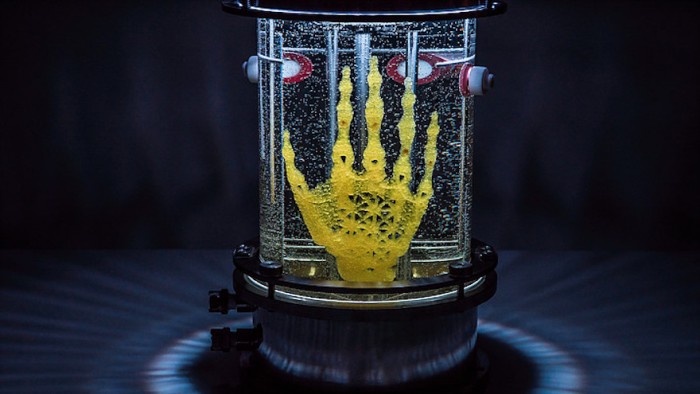
With the human body and technology becoming increasingly inter-clasped specifically through medical research, projects like the Regenerative Reliquary are pivotal to such exploration. Dedicated to investigating the relationship between technology and the human body through generative art, new media artist, Amy Karle set out to explore just how human cells can live outside of the human body through her creation of a human hand using stem cells. She is an active volunteer for numerous 3D printed prosthetic initiatives; amongst them Superhero Cyborgs, Kid Mob and E-Nable. It is this work and her unbridled interest in the human bone, which she notes as, “the structure and foundation that supports our bodies,” that served as an inspiration for her current project.
Most people think of human bones as a static component to our skeletal frame and yet it is so influential to maintain a healthy physique. Karle explains, “As I was exploring regenerative medicine, I was studying bones, medical implant design and additive manufacturing. I have been making 3D-printed artwork of many different kinds of bones, and have now turned my focus to the human hand. The most recognizable human bones are hands and skulls. We express ourselves through our hands and use our hands as tools.”
In collaboration with bioscientist Chris Venter and materials scientist John Vericella, Karle designed in Computer-aided Design and Drafting (CAD) a bone scaffold based on the structure of her own hand. The scaffold structure had to be porous enough to allow for cell growth and be constructed in such a way that it encouraged cell attachment. Vital to overall success the scaffold had to be created from a biocompatible and biodegradable material to give it an intricate, interlaced structure that seamlessly integrates into the shape of the human bones. A custom mix of Polyethylene (glycol) Diacrylate (Pegda) hydrogel – a cellular growth medium used in such things as petri dishes was used to achieve this. The structure is modelled on the spongy micro-lattices found in bones that make it flexible.
The printing process took several weeks and was executed on an Ember 3D printer, which is an open-source DLP Stereolithography printer, with capability to print on a microscopic level. It has a 50-micron resolution and a layer thickness of 10 to 100 microns. With the printer’s small build envelope, 64 mm x 40 mm x 134 mm, Karle needed to break-up her scaffold design into several parts prior to printing. After successful printing the 3D-printed hand scaffold was placed into a bioreactor, donated by San Francisco’s Exploratorium: The Museum of Science, Art and Human Perception. The bioreactor provides a conducive environment for cells to growth whilst also functioning as a showcase for the 3D-printed hand.
Next, she needed to find cells to grow on the scaffold and to give it a more personal meaning Karle wanted to use her own cells or cancer cells taken from a mouse – the latter was ruled out to be unsafe. She notes, “A major portion of this artwork that I'm creating is the cells used. I consider what does it mean for this specific piece to have human cells growing and proliferating outside of the body.” Currently, Karle is in the process of culturing the stem cells in preparation for seeding them onto the 3D-printed scaffold. This process entails ‘training’ stem cells to become bone.
"Essentially, this means that if it were to be applied medically, a patient’s own stem cells could be used, and—if all works well—turn to bone," says Karle, "which could be implanted into the body without rejection, since it would be of their own genetic material."
Whether she will be successful, only time will tell, but there is no doubt that this project transcends science and technology. The Regenerative Reliquary is currently on display at the Pier 9 space in San Franscisco.





